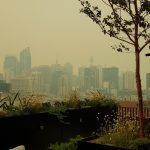Improved pharmacologic treatments and other interventions may be needed for the growing problem, experts say.
Patients may suffer exacerbations of certain skin conditions after just two weeks of exposure to bushfire smoke, potentially adding to the load on healthcare services during natural disasters.
That’s according to a new study led by the University of California investigating air pollution, topical and systemic medications (including prednisone) and dermatology clinic visits around the 17-day California Camp Fire of November 2018.
Although there were several potential ways air pollution could contribute to the development and exacerbation of atopic dermatitis, epidemiologic evidence for a link was conflicted and most research focused on chronic exposure, the authors said.
They collected daily data on average smoke plume density and 24-hour PM2.5 concentrations for San Francisco, as well as average temperature and relative humidity to control for other factors that could affect atopic dermatitis.
Data were collected for 18 weeks before, during, and after the fire and corresponding dates from the two previous years when there were no large bushfires close by.
Across the three periods the researchers identified almost 3,450 adult and 700 paediatric patients – totalling more than 8,000 visits – who were diagnosed by a dermatologist with atopic dermatitis or itch within a San Francisco tertiary care hospital system located less than 300km from the fire.
After adjusting for temperature, humidity, patient volume and age, they found a significant association between fire-related air pollution and heightened weekly clinic visits for atopic dermatitis among both adult and paediatric patients.
Children were also significantly ‘itchier’ as air pollution worsened: the authors found a 10g/m3 increase in the average weekly PM2.5 concentration was linked to a roughly 8% increase in paediatric itch clinic visits.
“Wildfire smoke exposure was associated with a significantly increased rate of clinic visits for itch among paediatric patients and rate of prescribed systemic medications for treatment of adult patients,” they wrote JAMA Dermatology.
“Both patients with atopic dermatitis and the general public may benefit from understanding the negative skin health effects of air pollution. This study suggests that clinics serving affected communities may experience increased visits for certain skin disease exacerbations that decrease patient quality of life and increase health care expenditures.”
In a linked editorial, healthcare reform expert Dr Kenneth Kizer said he believed it was the first study to link increased occurrence of atopic dermatitis and itch with acute bushfire smoke pollution.
He called for more comprehensive research into the issue – noting smoke composition can be highly variable according to weather, what is burned and the fire’s intensity, making the health consequences less predictable than from industrial sources.
“Because continuing climate change will likely worsen this situation and add skin health stressors (e.g., heat and increased UV radiation), it should be expected that the health care burden of atopic dermatitis and other air pollution-sensitive skin diseases will grow substantially in coming years,” said Dr Kizer, who is chief healthcare transformation officer at Atlas Research and was not involved in the study.
“Improved pharmacologic treatments and other interventions for these conditions will be helpful in addressing this growing problem, but more effective policies and practices to mitigate climate change and reduce wildfires will be even more helpful.”





